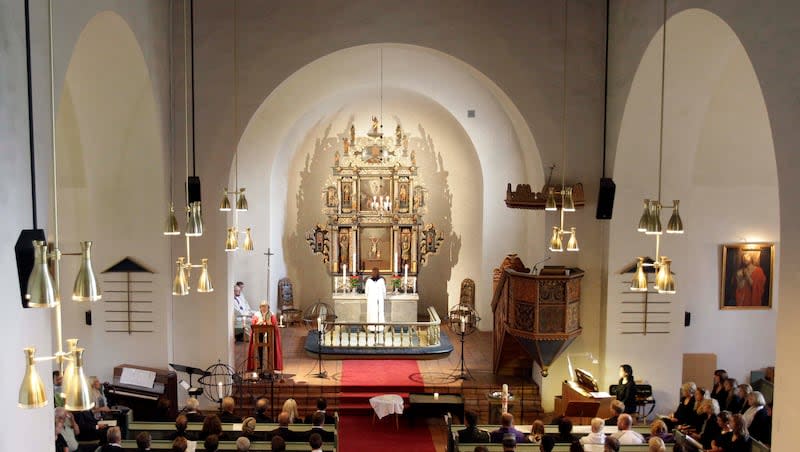The case for attending a Norwegian church service

- Oops!Something went wrong.Please try again later.
This article was first published in the State of Faith newsletter. Sign up to receive the newsletter in your inbox each Monday night.
If you’re loyal to a specific church, then it’s easy to forget what it’s like to encounter something unfamiliar at a worship service.
After all, most churches stick to the same order of worship week after week and choose hymns from a list of classics, rather than jumping all over the book.
In the best cases, these established religious routines free up your mind and enable you to listen more closely to the prayers and sermons.
In the worst, they trigger a sort of autopilot setting, where you’re going through the motions of worship, but not really connecting with what’s going on.
Although I’ve moved quite a bit as an adult, it’s been relatively easy for me to find familiar religious services in new places.
Nearly every Presbyterian Church (USA) congregation uses the same songs and prayers that I’ve been singing or reciting since birth. Even at non-Presbyterian, but still mainline Protestant, churches, my experience has been more akin to eating comfort food than sampling a strange, exotic dish.
As I mentioned above, that’s often a good thing. When I visit a church, I don’t want to be overwhelmed by newness. I want to have familiar routines to cling onto as I take on the challenge of meeting dozens of new people at once.
But this weekend, I realized what I’ve been missing by leaning into familiar routines. And it’s all thanks to Norway’s Constitution Day.
To be clear, I don’t live in Norway, but my town does celebrate the country’s Constitution Day, Syttende Mai, each May with a craft fair, parade, musical performances and Norwegian foods.
This year was my first chance to be part of the fun, and my family enjoyed seeing a traditional dance performance, attending a “bunad” fashion show and sampling lefse-wrapped hot dogs.
But the most memorable part of Syttende Mai for me was a local Lutheran Church’s Norwegian service. There, my mom and I were challenged to sing hymns in Norwegian — a language we do not speak — as the smell of warm meatballs, which were being prepped for the post-worship brunch, wafted over the congregation.
In most cases, we were singing hymns I know in English, which meant I could carry the tune even if my pronunciation was horrific.
And it really was horrific. How was I supposed to know how to say lines like these?
Hvilken venn vi har i Jesus! Alt han vet og alt formar.
Tyngste byrde han oss letter. Nar i bonn til ham vi gar.
But to my surprise, it felt wonderful to have no clue what to say. It felt wonderful to stumble through the songs and prayers and hear familiar beliefs professed in new ways.
I’m grateful for being forced out of my autopilot setting. I’m grateful for all my fellow worshippers who were there to lead the way.
Fresh off the press
What happens when efforts to honor fallen soldiers create religious freedom conflicts?
What’s missing from coverage of Harrison Butker’s ‘homemaker’ comments
Scottie Scheffler always leans on his faith. This week, even more so
Utah’s goalie has battled OCD and depression. The NHL just honored him with a major award
What Hulk Hogan said about getting baptized
Person of the week: Pierre Teilhard de Chardin
Pierre Teilhard de Chardin was a scientist and Jesuit priest who faced intense pushback from the Catholic Church for his efforts to integrate those two passions.
His religious superiors did not allow him to publish his scientifically inspired religious reflections during his lifetime, so he wasn’t recognized for his unique genius until after his death.
Teilhard became a priest in 1911, but didn’t spend much time doing traditional priestly things. Instead, he served as a stretcher bearer during World War I, got a doctorate in geology and went backpacking through China to conduct research on evolution.
“His writings on Christ were enhanced by an evolutionary perspective,” according to Religion News Service.
Teilhard is the subject of a new PBS documentary, “Teilhard: Visionary Scientist.”
What I’m reading...
As my town celebrated Norway, a town in Texas was being divided by a German-heritage festival. The New York Times reports that residents of Muenster, Texas, are battling over how to split the proceeds from selling beer during the festival — and how to keep a cherished tradition alive.
Also this month, The New York Times highlighted a troubling discovery in California related to jury selection practices. Notes in an old case file showed that attorneys were eliminating potential jurors for being Jewish or for seeming to be Jewish. The discovery may lead to the release or retrial of multiple people on California’s death row. “Retrying the cases would present prosecutors with numerous challenges, like tracking down old case files and witnesses whose memories may have faded, or who have died,” the Times reported.
Last week’s American Storylines newsletter on the dystopian world of tech-driven dating, aptly titled “Why nobody likes dating now,” made me very thankful for my husband.
Odds and ends
Remember the Oak Flat case? I’ve referenced it a few times here. A group of Native Americans is fighting to stop the U.S. government from selling their sacred land to a mining company. After losing in front of the 9th U.S. Circuit Court of Appeals, the Apache Stronghold has now appealed to the Supreme Court.
As someone who has trouble controlling her facial expressions, this funny video from the world of tennis really spoke to me.

